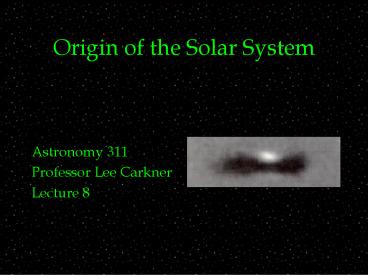Origin of the Solar System - PowerPoint PPT Presentation
1 / 24
Title:
Origin of the Solar System
Description:
In the outer solar system you have more material (both volatiles and refractory ... Inner solar system -- volatiles boil off, resulting in small rocky planets ... – PowerPoint PPT presentation
Number of Views:280
Avg rating:3.0/5.0
Title: Origin of the Solar System
1
Origin of the Solar System
- Astronomy 311
- Professor Lee Carkner
- Lecture 8
2
What would be the easiest way to increase the
magnification of your telescope?
- Increase the size of the primary mirror
- Increase the size of the secondary mirror
- Use an eyepiece with a longer focal length
- Use an eyepiece with a shorter focal length
- There is no way, the magnification of a given
telescope is fixed
3
Which of the following types of electromagnetic
radiation are best studied from space?
- Ultraviolet
- Radio
- X-ray
- a and c only
- a, b, and c
4
Quiz 1 Monday
- Covers lectures 1-8 and associated readings
- About half multiple choice (20 questions), half
short answer/problems (4 questions) - Study
- Notes
- Can you write a paragraph explaining each major
concept? - Exercises
- Can you solve all the exercises with no
resources? - Readings
- Can you do all the homework with no book and
Quizdom questions with no notes? - Bring pencil and calculator!
- No sharing!
5
The Solar System
- Questions
- When did it form?
- Why does it have structure?
6
Structure of the Solar System
- The solar system has three distinct regions
- Inner Region
- Mercury, Venus, Earth, Mars, Asteroids
- Outer region
- Jupiter, Saturn, Uranus, Neptune and Moons
- Trans-Neptunian region
- Kuiper Belt and Oort Cloud
7
Where Did the Solar System Come From?
- We cant look back in time to see how the Sun and
planets formed, but we can look at young stars
that are forming today
8
Star Formation
- Stars are formed in clouds of gas and dust when a
clump of material starts to contract - The mutual gravity of the particles in the clump
causes the contraction to continue - Conservation of angular momentum makes the clump
spin faster - Rapid rotation causes the outer layers to form a
disk
9
Circumstellar Disks
- We also can see them silhouetted against a bright
background in Hubble images - Disks are common around young stars
10
From Disks to Planets
- Many stars between 1-50 million years old have
disks, but stars slightly older generally do not - Where does the disk go?
- A disk has more surface area than a group of
planets with the same mass, so it radiates more
light
11
How Do Planets Form?
- There are 4 stages to planet formation
- ?
- ? grains stick together to form
planetesimals - ?
- ? gas and leftover planetesimals are
cleared from solar system
12
What Was the Solar Nebula Made of?
- Solar Nebula --
- From studying meteorites and star forming regions
we hope to discover what the solar nebula was
made of - Two basic components
- Gas --
- Dust -- made of rock (silicates), metal (iron)
and ices (water, methane, ammonia, carbon dioxide)
13
Solar System Dust Grain
14
Accretion of Grains
- Dust grains are very small (form planets?
- If dust grains are fractal they may stick
together more easily - At the end of this stage the solar system is
populated by a few thousand planetesimals, such a
system is invisible to telescopes
15
Accretion in a Protoplanetary Disk
Disk
High Density
Low Density
Star
Larger Grains move to center
16
Temperature and the Solar Nebula
- Two basic types of dust in solar nebula
- Volatiles --
- Refractory Material --
- Temperatures were higher in the inner solar
system and lower in the outer solar system - Near the Sun the volatiles boiled off leaving
only the refractory material behind - Outer solar system -- icy planetesimals
17
Regions of Formation
Icy
Rocky
Gas
Temperature
18
Planetesimals to Planets
- Due to gravity and intersecting orbits the
planetesimals collide with each other - Planet formation happens differently in inner and
outer solar system
19
Formation of Gas Giants
- In the outer solar system you have more material
(both volatiles and refractory material), so
planets are larger - No more hydrogen gas after a few million years
- Thus, in the outer system where the temperatures
are lower you have gas giants
20
Formation of Terrestrial Planets
- Result is small rocky planets with no large gassy
outer layers
21
Accretion of the Inner Planets
22
Orbital Evolution
- This causes
- Shifting of the orbits of the Gas Giants
- Icy planetesimals ejected to form the Kuiper Belt
and Oort cloud
23
The Final Solar System
- Our picture of planet formation is driven by an
attempt to explain our own solar system and its
three regions - Outer or Gas Giant region
- We have also found other types of planetary
systems different from our own
24
Steps in Solar System Formation
- Inner solar system -- volatiles boil off,
resulting in small rocky planets - Outer solar system -- large planet cores form
rapidly from refractory and icy material, acquire
large gas envelopes - Edge of solar system -- leftover and ejected icy
planetesimals form Kuiper belt and Oort cloud































